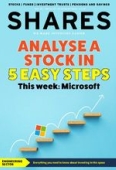Archived article
Please note that tax, investment, pension and ISA rules can change and the information and any views contained in this article may now be inaccurate.
Frustrated with a share price going nowhere? Here are reasons why they can trade sideways

It can be frustrating to watch share prices trade sideways for months. Nervous investors might question that something is going wrong with the investment case.
However, that isn’t necessarily the case and there could be several reasons which explain lacklustre share prices. This article examines why it happens and highlights some factors which may give clues to what lies ahead.
WHY DO SOME SHARES DO NOTHING?
It is unrealistic to expect shares to outperform all the time. A lack of news flow can leave shares stranded as investors wait for new information to appear.
A strong period of outperformance is often followed by a quiet spell as shares consolidate gains and some investors elect to take profits.
This can be compounded by a delay in analysts upgrading earnings forecasts. Academics have long known about the effect; it means bad news travels fast and good news travels slowly.
It can therefore take time for consensus estimates to catch up and for positive news to be reflected in higher earnings estimates. Importantly, improving earnings revisions can be a trigger for institutional investors to buy.
Shares can also go quiet for non-fundamental reasons which are hard to identify and just part of the way markets work.
SHOULD INVESTORS WORRY IF A SHARE PRICE FLATLINES?
At some point, it is natural for investors to ask if the lack of share price movement is a situation they need to worry about.
It is difficult to be prescriptive, but it is useful to keep an eye on volumes traded. Quiet sideways moves within a channel typically happen on low trading volumes.
A marked increase in trading volumes accompanied by a breakout through the bottom of the trading range could signal big institutions selling out.
It is also worth keeping an eye on consensus analyst earnings revisions. When more than one analyst lowers their forecasts, it can be a sign of softer trading and potentially trouble ahead.
FLYING HIGH BUT FOR HOW LONG?
Central European budget airline Wizz Air (WIZZ) has been upbeat about its prospects in recent results, but its shares have drifted sideways for most of the year.
However, it is worth noting that the share price performed very well in the tail end of 2022 so it’s possible that investors simply got ahead of themselves, and the shares are consolidating strong gains.
We’re already seeing a strong recovery in demand for air travel post-pandemic.
Wizz Air’s earnings estimates for the year ending March 2024 are up nearly 50% since December 2022 according to Refinitiv data but estimates for the year to March 2025 looks far less convincing. Upgrades of only 5% suggest less conviction for earnings further out.
Shares in Jet2 (JET2:AIM) and EasyJet (EZJ) have displayed similar sideways share price patterns to Wizz Air, and all three have weakened in recent weeks as concerns grow about short-term disruption from wildfires in various popular tourist destinations.
HOTEL PRICES THROUGH THE ROOF
Crowne Plaza-to-Holiday Inn owner InterContinental Hotels (IHG) has drifted sideways since February in a narrow range.
Like the airlines the company has benefited from a return of tourism and business travel. InterContinental Hotels has seen a steady if unspectacular increase in earnings revisions since the start of 2023.
Industry experts have warned that US and European hotel rates are set to become more expensive over the next two years as supply has failed to keep up with demand. That is positive for hotel earnings.
In the US supply is barely growing while tighter lending standards following the mini-banking crisis are making it harder for some developers to secure finance to build new hotels.
Average US hotel rates are around 17% higher than before the pandemic at $157 a night. In Europe the trend is even more stark with prices in Paris 50% higher while London prices are 30% above 2019 levels.
However, it is questionable how long customers can continue to fork out higher prices. According to an RBC research note US hotel bookings have shown negative year-on-year growth for the last three consecutive months.
ROLLS-ROYCE HAS BROKEN OUT OF ITS TRADING RANGE
A good example of a share trading sideways before breaking upwards through the upper band on a positive news trigger is aircraft engine maker Rolls-Royce (RR.).
The shares traded in a narrow price range between 144p and 158p from early March until 26 July when the company announced strong first-half trading materially above consensus expectations, sending the shares up 20% to 182p.
The company, under new CEO Tufan Erginbilgic, said it expects underlying operating profit of £660 million to £680 million compared with consensus analysts’ expectations of £328 million.
Furthermore, the company raised full year operating profit guidance by 39%, based on the middle of the new £1.2 billion to £1.3 billion range.
Erginbilgic has been scathing of Rolls’ operating performance and pledged to transform the business by targeting inefficiencies and exiting low return parts of the business. The plan seems to be paying off earlier than investors and analysts expected.
KEEP YOUR EYES ON PETS AT HOME
After raising full year profit guidance at the end of January, shares in pet food-to-vet services specialist Pets at Home (PETS) jumped by around a tenth but since February they have moved sideways between 350p and 400p.
Full-year results published in May showed record sales while underlying pre-tax profit was up 8%. The company also revealed a new medium-term strategy to build the world’s best unified pet platform.
Pets at Home is already the leading UK player with 24% market share of the roughly £7.2 billion pet care sector. The company is now aiming to scale its unique position where it is the only player that combines products, services and expertise across the full pet care market.
Once built the platform will be accessed via a unified pet care app enabling consumers to fulfil all their pet care needs, from booking surgical appointments to ordering repeat prescription deliveries and managing nutrition subscriptions.
Financially, the company is targeting 10% compound annual growth in pre-tax profit and driving higher operating margins by improving the sales mix with vet revenues growing faster than the group average.
Pets at Home looks well positioned to continue growing market share in an expanding market. However, the key sticking point is valuation.
Trading on 18.9 times forecast earnings for the current financial year, the company will need to give analysts new reasons to upgrade earnings estimates if it wants the share price to break out of its current trading range.
A trading update is scheduled for 4 August and that could be the important catalyst to get the stock moving again. Good news could lift it out of the recent trading range, but bad news could go down like a lead balloon.
Just remember that stocks trading on high ratings (as is the case with Pets at Home) can see a large share price decline if they deliver even the slightest bit of bad news.
Important information:
These articles are provided by Shares magazine which is published by AJ Bell Media, a part of AJ Bell. Shares is not written by AJ Bell.
Shares is provided for your general information and use and is not a personal recommendation to invest. It is not intended to be relied upon by you in making or not making any investment decisions. The investments referred to in these articles will not be suitable for all investors. If in doubt please seek appropriate independent financial advice.
Investors acting on the information in these articles do so at their own risk and AJ Bell Media and its staff do not accept liability for losses suffered by investors as a result of their investment decisions.
Issue contents
Feature
Great Ideas
News
- Smithson bounces back from a poor year with significant outperformance in 2023
- Domino’s Pizza shares up 42% in a month but analysts still to be won over
- The important points from Barclays, HSBC, Lloyds and NatWest results
- How Adobe rode the AI wave to gain 50% in 2023
- On The Beach’s shares are looking ill after halving in six months

 magazine
magazine








